This experiment is for all ages, as the colored smilies show. You can do the algae and pollution experiment with your whole family together!



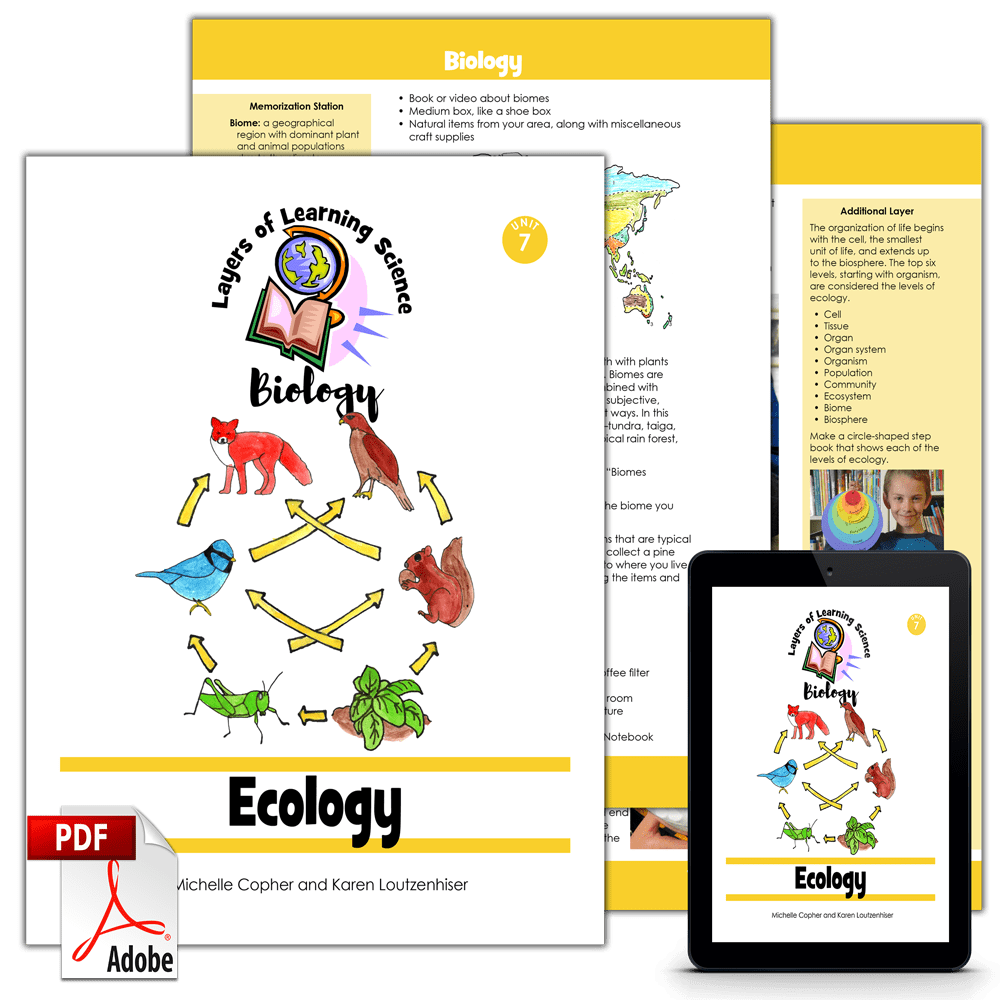
The algae and pollution experiment is a Biology experiment from the Layers of Learning Ecology unit. Layers of Learning has hands-on experiments in every unit of this family-friendly curriculum. Learn more about Layers of Learning.
Algae grows naturally in ponds and is a normal part of the ecosystem of a pond. However, certain pollutants can affect the growth of algae. Phosphorus is one of the most important nutrients for plant growth, but if too much phosphorus makes its way into a pond, river, or lake, it can cause the algae and other aquatic plants to explode in growth. They use up all the oxygen in the water and suffocate out other life forms like frogs and fish.
Acid rain is another problematic pollutant. If the pH level is outside of the normal range in water, then it kills off the algae and other living things.

Step 1: Library Research
Before you begin exploring, read a book or two about pollution. Here are some suggestions, but if you can’t find these, look for books at your library about pollution, water pollution, conservation, and phosphates. The colored smilies above each book tell you what age level they’re recommended for.
As Amazon affiliates, the recommended books and products below kick back a tiny percentage of your purchase to us. It doesn’t affect your cost and it helps us run our website. We thank you!

You Wouldn’t Want To Live Without Clean Water!
by Roger Canavan


My River: Cleaning Up the LaHave River
by Stella Bowles

Step 2: Algae and Pollution Experiment
WARNING: This experiment uses chemicals that can be dangerous if handled incorrectly. Keep out of reach of small children, wear gloves when handling chemicals, and never mix two chemicals together.
For this experiment you need jars, pond water, chemicals containing phosphates like detergents or fertilizer, and vinegar, which is an acid.


Before you begin this experiment get the scientific method worksheet and use this process to set up your experiment.
Collect two or more jars and add pond water to each jar to the same level. If you can actually see some larger patches of algae to scoop up, it will sure help the process to be quicker.
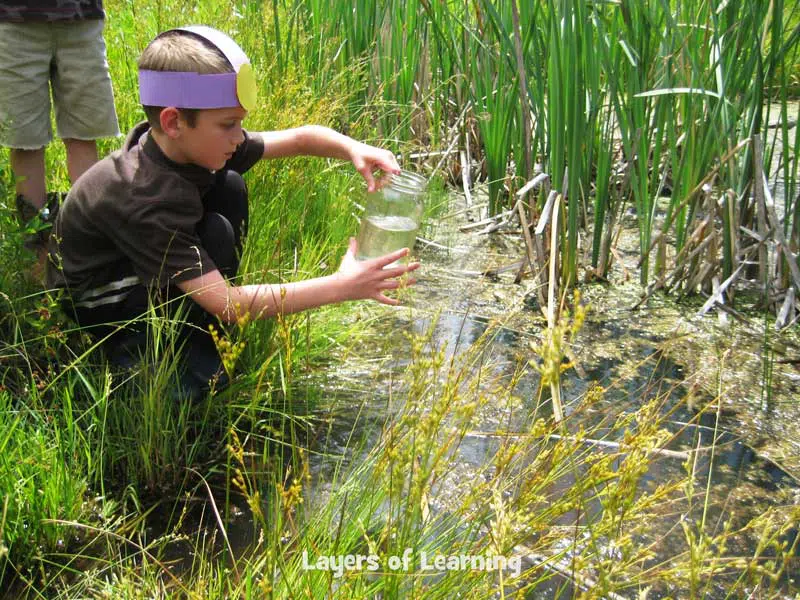
Let it sit in a sunny spot for a week to get growing.
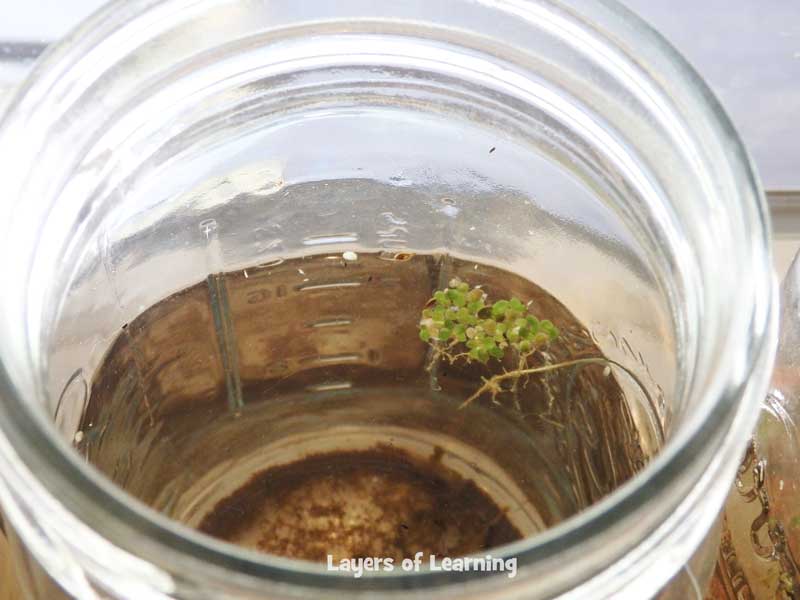
Label one jar “Control” and leave it chemical free. It will be the jar you compare your others to.
At this point you are going to design your own experiment with the chemicals you want to use. You can use phosphate-containing chemicals to see how phosphates affect the growth of algae or you can use vinegar to see how acid rain might affect the growth of algae. If there are other common pollutants you are concerned about, you can try those in your experiment jars too.
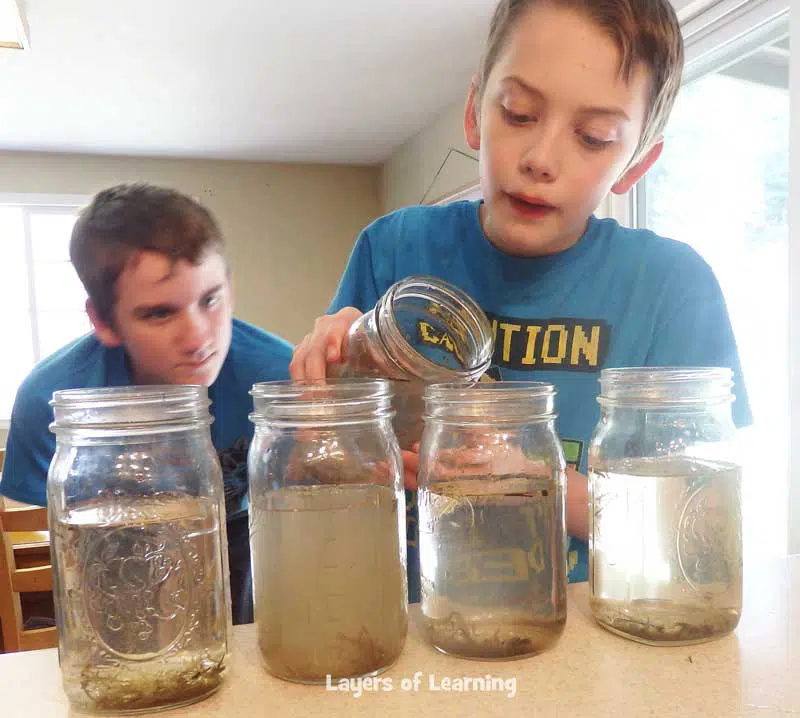
Add only one chemical per jar. DO NOT MIX CHEMICALS WITH EACH OTHER!
Here are some choices to add to your jars.
- Laundry or dishwasher detergent with phosphates
- Laundry or dishwasher detergent without phosphates (to test against phosphate detergents to see if it is the phosphates that are making the difference).
- Fertilizer
- Bone meal
- Vinegar
Be sure to properly label the jars then set them in a place with warmth and sunlight for 1-2 more weeks and observe the growth.
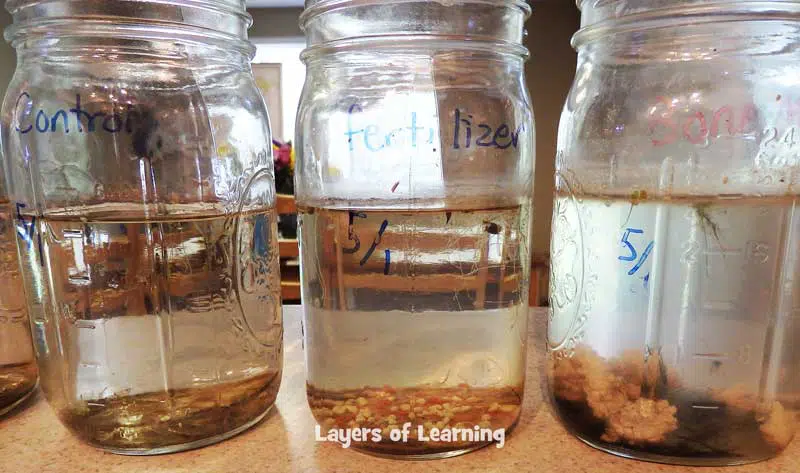
You can observe the different amounts of growth by eye and even observe some of the algae that is too small for the naked eye under a microscope by placing a drop on a slide and observing it. You can also watch for color changes or density changes within the samples.
Which conditions created greater algae growth? Which created less? What does this tell you about the effect of things like fertilizer and detergent pollution? Acid rain? What affect does rampant algae growth have on a pond or a lake environment? What does too little algae growth mean for a pond or lake environment? Do you think all types of algae would respond the same way to pollutants that your variety did?
Step 3: Show What You Know
Complete your scientific method worksheet. On the back side make some notes about how you would adjust the experiment next time or further experiments you could make.
Additional Layers
Additional Layers are extra activities you can do or tangents you can take off on. You will find them in the sidebars of each Layers of Learning unit. They are optional, so just choose what interests you.
Deep Thoughts
Did you go into the experiment with expectations of what would happen? Real scientists do too. It’s called a hypothesis.
Good scientists don’t let their hypothesis get in the way of the truth though. If their experiment proves them wrong they’ll change their minds.
How did you control for bias in your experiment? Can you redesign the experiment to be even more fair?
Additional Layer
How does a city sewage system work? How might pollutants leak from your home into ponds and lakes in your area from the city sewage?
What if you live in the suburbs or country and have a septic tank? How can pollutants affect the area then?
Additional Layer
Scientists and entrepreneurs are looking at using certain types of algae to produce bio-fuels. Research more about this.

Get a Free Unit
Choose between the first unit in each Layers of Learning subject to try for free when you sign up for the newsletter.
We never spam and you can cancel your subscription at any time.


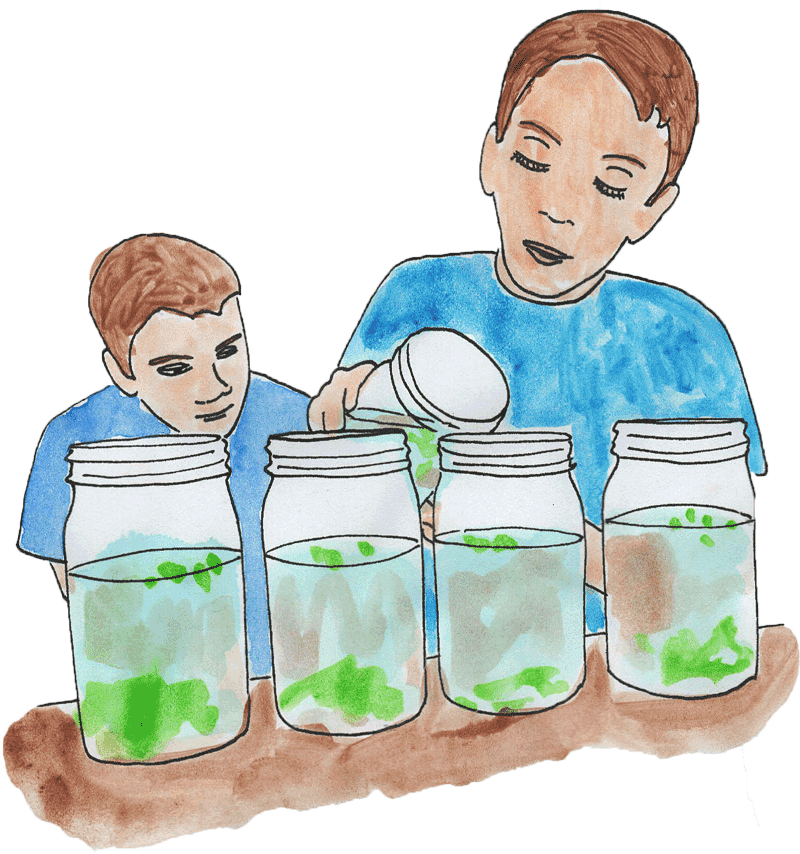




Is a T a tablespoon or teaspoon?
Capital T is tablespoon.
This is not a detailed idea for an experiment. It is not this simple. Algae will not survive with simply scooping up pond water and sitting it outside. Waste of time.
Yes, algae will survive if it is in sunlight, at least for the few days or weeks required for the experiment. Also, the details of the experiment are purposely left up to the child. Part of this lesson is learning to think independently and creatively as opposed to following a recipe.
Hi there! I’m doing a research project on How pollution affects algae, and I was hoping if you could possible elaborate more on how pollution effects algae and it’s environment. Great experiment by the way!
Hi Diana, there is tons of research about how algae growth is an indicator of pollution. Here is one article to get you started: http://www.walpa.org/waterline/june-2012/algae-can-function-as-indicators-of-water-pollution/. There are many kinds of algae and many kinds and amounts of pollution, so the specifics will vary, but in general, as algae has specific growing requirements, you can observe how algae growth is either rampant or stunted by what is present within the water it is growing in. We recommend that you look up several scholarly journals that detail ecological experiments dealing with pollution’s effect on algae growth. This is a topic that is easy to find. Best of luck on your project.
Can you please clarify what detergent does/does not have phosphate? thank you
Just read the labels. They will say if they have phosphates. If they do not have phosphates they are usually labeled “phosphate free”. In some places phosphates are illegal (Washington State is one I know of) in laundry detergent, so you won’t find them on grocery shelves.
If you’re still on the topic, I did a lot of looking for detergent with phosphates and I found that phosphates have been banned from detergent because they promote algae growth. This ban caused literally every company to remove phosphates from dish soap, detergent, hand soap, and basically any soap you can find. Luckily, if I did my research correctly, you can just buy trisodium phosphate (TSP) which is marketed as a “heavy duty” all purpose cleaner from home depot for about $7.
Yes, phosphates became banned in several states in the US and so manufacturers have changed their formulas. Dishwasher soap still often has phosphates because the bans applied primarily to laundry soaps. Thanks for your tip.
How do you measure or weigh the algae growth?
You won’t be measuring it quantitatively. You will observe the growth. As your algae grows, it will become more and more compact inside the container. As the algae population gets more dense, it also becomes more opaque. You will visibly see growth and may see color changes, depending on the type of algae you collected. You can also put a sample drop of water on a microscope slide for a view of some of the algae that is present but too small to see with the naked eye.
Could we use plant lights instead of placing the jars outside?
Yes, that should work well.
When you scoop the water, do you need to make sure algae is collected, too?
Not necessarily. The pond water will contain organisms too small for you to see and then you can watch it grow. However, if you can begin with some visible algae, it will speed up the process and be easier and quicker to observe.
I want to do this expirament for school,But I have a few questions.I have until the end of febuary to do this,will algae grow in time if I use pond water and leave it by a window?Is the lid off the jar better than on?Does the pond water I collect have to already have some algae in it?And how can vinegar playing as acid rain somehow relate to real life pollution problems and etc,any ideas?
Yes, the algae will grow in time. Keep it in a place that is warm and in sunlight. A windowsill is perfect. Leave the lid off so it can breathe. Yes, the pond water needs to have some algae in it to start, though there is probably some in any pond water even if you can’t see it. Still, it is best to be sure. Vinegar is like acid rain only in the acidity level. You should do some research on what acid rain is and how pollution makes the rainwater acidic. You can start with this page from the United States EPA.
Thank you . I really needed help in an activity. i didn’t have much ideas. you all helped it a lot. get going. Doing a great job guys.
Will the algae be in the water in cold weather still? I don’t mean in the dead of winter, but around Halloween?
Is algae still alive in pond water around Halloween in Central Maine? The temperature is about 45-60 degrees Fahrenheit.
Algae probably isn’t actively growing at this time of year, but if you collect pond water and bring it indoors to a warmer temperature it should take off and begin to grow.
How can I expand on the experiment? What could I use as a hypothesis?
You could hypothesize about the effects of any variety of specific chemicals on algae growth. Your hypothesis would include what you predict would happen specifically when the algae is exposed to a particular contaminant.
Ok, thank you!
What are the measurements for these? How much water and how much algae do I use for this experiment to get good results?
Exact measurements aren’t important. Just fill the jar most of the way and capture some algae, even a little algae will grow to much more in a few days if given sunlight.
How much pollutant should I add to two cups of water?
I would add about a tablespoon, but you can design the experiment however you like.
Does the container have to remain open, and is it okay to leave it inside by a window? or does it have to be outside?
The container should be left open and it can be inside. It just needs to have light, so in a window sill is perfect.
Okay, thank you!
Would the “pollutants” be the vinegar, bone meal, and fertilizer?
The specific pollutants you use are up to you, but those are a few ideas. You can just do one jar with one of the pollutants recommended, or you can use several jars, each with one pollutant. For example, you may have one jar with water and algae that you add fertilizer to while you have another jar with water and algae that you add vinegar to. In addition, make sure to keep one control jar that you haven’t polluted at all. You will be comparing the algae growth between the jars.
whats the conclusion of this experiment meant to be? Like what will I find after doing this experiment?
The nature of an experiment is that you have to do it to find out. Otherwise it is a recipe.
How much Bone meal and other stuff like that do i put in the pond water ?
Chloe, it’s up to you. You are the experimenter. You can approach this in different ways. If you want to simulate a real polluted body of water, then you need to do research to find out how many parts per million of pollutant is in the pond or lake, then figure out how much you would need from that.
If you just want to see what kind of general effect the pollutant has on growth, then as long as you carefully measure and keep your data records, then you can use your judgement. It might also be cool to try several different concentrations of the same pollutant in multiple jars instead of trying different pollutants in each jar. For example, you could try 1 gram, 2 grams, and 3 grams of bone meal in three different jars.
okay thank you! I also forgot to ask another thing, would I be able to use creek water because i have one by my home.
is karen the maker of the layer of learning? i need this infomation for my science fair project
Michelle Copher and Karen Loutzenhiser are the authors of Layers of Learning.
How long will it take for the algae to appear im doing an experiment about this for school and it needs to be done by a certain time.
That really depends on the type of algae you collected, the temperature of the water and air, and other factors. We could begin to see growth within a week and had significant growth in about a two weeks, but it’s dependent on your conditions. Good luck!
does it have to be pond water or would i be able to use something like salt water
It needs to be pond water. You are collecting microorganisms along with the pond water.
How many days do we have to let it sit out until it observes growth.
This is meant to be an experiment, not a recipe. You are the scientist. You set the parameters for the test. A minimum would be a week, but longer is better.
This experiment makes no sense at all. I can’t get the 1 qt jars cause they cost to much. And i can’t use pond water/
You can use any jars including those that you save from food packaging, like peanut butter or jam jars.
Why does it need to be pond water instead of distilled water
You have to have algae from pond water plus the things the algae eats that are in the pond water. You are testing natural waters and the effect pollution has on them.
Can you tell me the exact measurements for each material you used because I have a science fair coming up and I need the measurements for my project.
Hi Anne,
There aren’t any specific measurements required. You will need to measure your own experiment and use those measurements. This same experiment has been done many times and in many ways. You will need to decide how much pond water you want in each jar (making it the same in each one) and then decide which pollutants you want to experiment with. As long as you track what you use, it will be an accurate experiment. A friend of ours is an environmental scientist and he goes around to ponds, lakes, and rivers all over our regions conducting this exact same experiment over and over again each year. This is what real scientists do to see the effects of pollutants on aquatic environments. Good luck!
Do you need to keep the lids off of the jars? Is oxygen needed for algae growth? Thank you for this experiment. We’re going to start it at the library next week for an Earth Day program.
Plants require carbon dioxide for photosynthesis and the algae will do better with the lids off. But it would be a good experiment to have a jar with the lid on and one with the lid off and everything else the same.
That’s a great idea. Though not sure if I have another jar. But if I do, I’ll try it! Thank you so much.
What was the conclusion at the end?